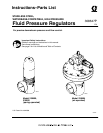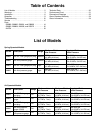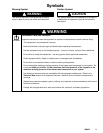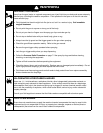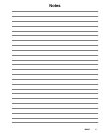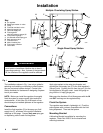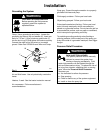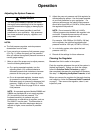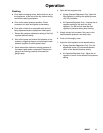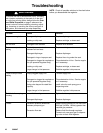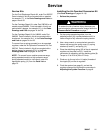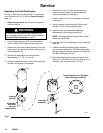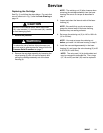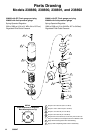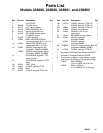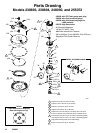
8 308647
Operation
Adjusting the System Pressure
CAUTION
D The new system must be cleaned and tested
thoroughly before admitting fluid to the regulator
to avoid contaminants clogging or damaging the
regulator.
D Always use the lowest possible air and fluid
pressures for your application. High pressures
can cause premature spray tip, regulator, and
pump wear.
NOTES:
D The fluid pressure regulator controls pressure
downstream from its outlet.
D If you are using an accessory fluid pressure gauge
(H in Fig. 1), relieve the spray gun line pressure
after you reduce the regulator pressure to ensure a
correct gauge reading.
1. Make a note of the proper way to adjust pressure,
from the following descriptions:
D On a spring-operated regulator, turn the
adjusting screw (10) counterclockwise to
decrease pressure and clockwise to increase
pressure to the spray gun or extruder gun.
D On an air-operated regulator, increase supply
air pressure to increase fluid pressure.
Decrease supply air pressure to decrease fluid
pressure. Supply air up to 100 psi (0.7 MPa,
7 bar). See the chart on page 20 for air versus
fluid pressure.
NOTE: Air-operated regulator Models 238893 and
238894 are provided with an air supply regulator
(31) to control the fluid set pressure. For
increased sensitivity in pressure set point
performance, an alternative air regulator, such as
Part 206197, may be used. This alternative air
regulator uses a sensitive diaphragm design to
maintain a higher, more accurate air pressure
setting.
2. Adjust the pump air pressure and fluid regulator for
the desired spray pattern. Use the lowest possible
air and fluid pressures for your application. For
optimum performance, the inbound fluid pressure
should be at least 500 psi (3.4 MPa, 34 bar) above
the regulated fluid pressure.
NOTE: Do not exceed a 2000 psi (14 MPa,
138 bar) pressure drop between the regulator inlet
and outlet. Excessive pressure drop will cause
premature regulator component wear.
For example: With 3500 psi (24.5 MPa, 245 bar)
to the regulator, the minimum regulated outlet
pressure would be 1500 psi (10.5 MPa, 105 bar).
3. In a circulating system, also adjust the back
pressure valve (K).
4. Record all the settings for future reference.
Cleaning the Regulator
Do not allow fluid to settle in the system.
Flush the regulator whenever the rest of the system is
flushed (see page 9). Before you flush the system,
follow the Pressure Relief Procedure on page 7,
then completely decrease the regulated fluid pressure.
See step 1 in Adjusting the System Pressure, at left.
Before you remove the regulator for thorough cleaning
and inspection, follow the Pressure Relief Procedure
on page 7. Then remove the regulator, clean it, and
inspect all parts.



